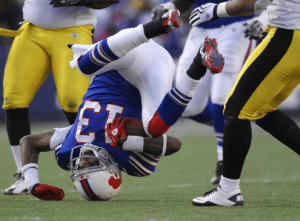Repeat Head Injuries Create Legal Issues in Sports
Head Injuries and the NFL
During his NFL career from 1958-1972, Wayne Walker received over 20 concussions in 200 games, getting knocked out twice. On October 29, he announced that he suffers from Parkinson’s disease, a degenerative nerve disorder. While Parkinson’s is normally genetic, it can also be triggered by other factors. Walker said in the interview that once he completely lost consciousness but returned to the field in the same game.
In May 2015, Adrian Robinson, a former NFL player, committed suicide. It was confirmed after his death that he had chronic traumatic encephalopathy (CTE), one of the more common diagnoses for football players. Some effects of CTE are commonly referred to as being “punch drunk.” There are many symptoms of CTE, which can include depression, memory loss, and aggression. 
In addition to CTE, the risk for Parkinson’s, ALS, Alzheimer’s, and other neurological diseases is much higher for NFL players. The brains of many NFL players have been studied after death, and at least 70 have showed signs of disease. The Concussion Legacy Foundation at Boston University found evidence of CTE in 88 out of 92 NFL players studied so far. Perhaps it should come as no surprise that this March, Chris Borland retired from the San Francisco 49ers at age 24. He felt that as a professional linebacker, he could avoid the risk of repeat brain trauma and the progressive neurological diseases that often follow.
Head Injury Lawsuits
There are often limits to how liable others are for sports injuries. Athletes often “assume the risk” or consent to anything that happens while playing a rough-and-tumble sport. However, there may be legal recourse for equipment failures, play that violates the rules of the game, or, as in the case of the NFL, leagues that misinform players about the risks involved.
Earlier this year, a judge approved a settlement of at least $900 million dollars a suit filed by retired NFL players and their families. The lawsuit claimed that the NFL knew of the dangers of traumatic head injuries and did not disclose them to players. The proceeds of the suit will allow for players or their heirs to receive up to $5 million for a diagnosis of ALS, $4 million for diagnosis of CTE, and up to $3.5 million for Parkinson’s and Alzheimer’s. However, the amount of money is currently being challenged as insufficient to cover all of the potential injuries caused by the game.
Riddell, a helmet manufacturer, has also been implicated in several lawsuits. Retired NFL players have attempted to sue the company, and the NFL declared that Riddell would no longer make their “official” helmet in 2013. Families of high school athletes in Colorado, California, and now New Jersey have also brought suit against Riddell for injuries on the field.
What is the Best Way Forward for Football Players?
Now that society is becoming aware of the dangers of repetitive head injuries, many steps are being taken to make football safer. The NFL is taking action to try to reduce head injuries on the field, and has donated $30 million to the National Institute of Health (NIH) to study the effects of concussion. At all levels of the game, coaches and players are paying more attention to safety. Yet, as one NIH flyer states, “every year, between 1.6 million and 3.8 million sports-related concussions are estimated in the United States, particularly among young athletes.”
The NIH advises coaches, players, and their families that they should learn to recognize the signs of concussion: all concussions are serious, and most occur without loss of consciousness. Not all concussions are caused by blows to the head, but can also be caused by “a blow to the body that causes the head and brain to move rapidly back and forth.” If a player seems drowsy, slurs speech, has a headache, has memory problems, or has any other signs of concussion, they should be taken out of play and given medical attention. Importantly, they should also not be allowed to play again until a doctor says that they can.
Personal injury and product liability lawsuits will also continue to hold organizations, manufacturers, and even individual coaches accountable for failing to protect players in certain cases. If you or someone you know has suffered from football-related head injuries, you may wish to contact an attorney to see if you have any legal recourse.


Comments